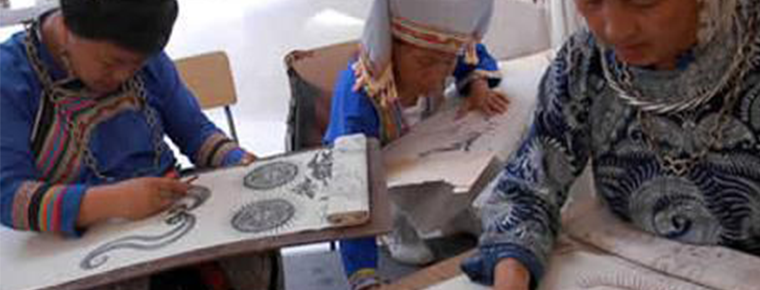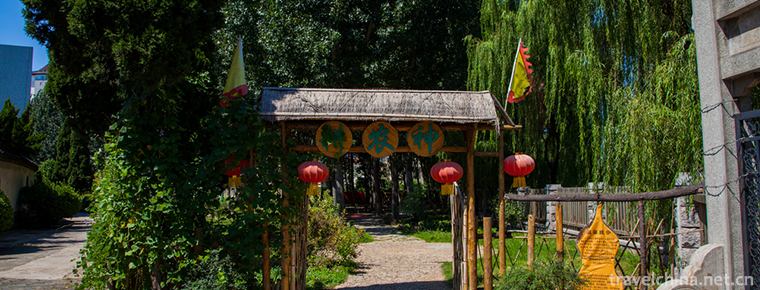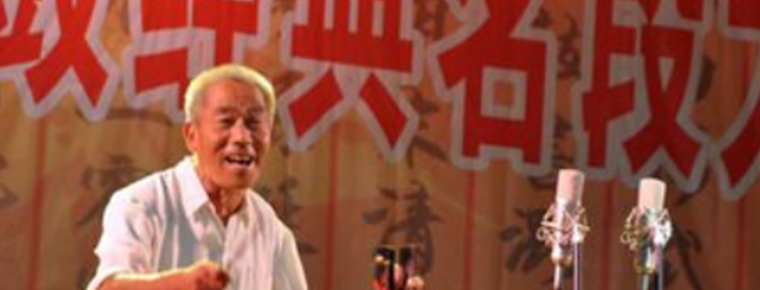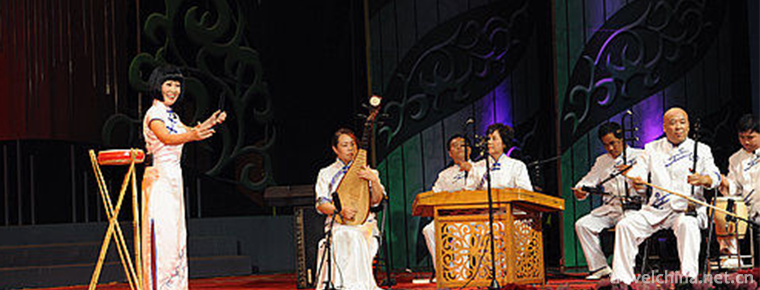Batik art
Batik art
Miao batik technology, the traditional handicraft of Danzhai County, Guizhou Province, is one of the national intangible cultural heritage.
Batik dyeing is one of the ancient folk traditional printing and dyeing techniques of the Chinese nation. As early as the Qin and Han Dynasties, the Miao people had mastered batik dyeing techniques, and the Song Dynasty reached its peak.
On May 20, 2006, Miao batik technology was approved by the State Council and listed in the first batch of national intangible cultural heritage list, project number_-25.
historical origin
As early as the Western Zhou Dynasty (11th century BC - 771 BC), dyeing and weaving technology in China had been greatly developed. According to the records of Li Ji and other documents, there was an official in charge of dyeing fabrics at that time called "dyeing people". In Chu State, there was also a "blue Yin" official specially responsible for the production of indigo. It is obvious that the silk weaving and dyeing processes at that time were quite large-scale.
Miao batik has a long history, many places are popular with "Batch Dyeing Song" (ancient song), narrating the origin of batik. As early as the Qin and Han Dynasties, the ancestors of the Miao nationality had mastered batik technology. According to the "Tongzhi of Guizhou Province", the batik cloth was once known as "appendix-dry patches" when wax-painted flowers were dyed on cloth.
Wax curtain (batik) was very popular in Wuxi area of Song Dynasty. In Ming and Qing dynasties, Miao people in central Guizhou also used batik clothing. During the period of the Republic of China, batik was prevalent among most Miao people in Western Hunan, Guizhou, Yunnan and southern Sichuan, while Danzhai, Anshun, Langdai (today's six branches), Puding and Huishui were the most skilled places in Guizhou. In most areas, batik products are used as clothing, while in Western Hunan, batik products are used as bed sheets, curtain edges, pillow towels, etc.
Danzhai County, Anshun County and Zhijin County are multi-ethnic inhabited areas with Miao as the main body. In the long-term hardship of isolation from the outside world, the inhabitants here gradually formed a self-sufficient way of life, thus preserving the ancient batik skills. According to Miao custom, all women are obliged to inherit batik skills. Every mother must teach her daughter how to make batik. So Miao women learn this skill from an early age. They grow indigo and plant cotton, spin and weave cloth, paint wax, dye and cut, and inherit it from generation to generation. In this situation, the Miao community has formed a batik art-led costume, marriage Festival rituals, social ways, funeral customs and other customs and cultures.
Technological process
Technological process
Batik dyeing process includes: cloth fabrication, wax production, blue indigo production, waxing, dipping, dewaxing, stitching and more than ten processes.
Among them, waxing is the most important. There are two ways of waxing Miao batik dyeing: one is to use the hollow plate of printing, that is, to press the fabric with the hollow plate first, and then pour wax into the hollow place; the other is to use a wax knife made of three to four inches of bamboo pen or copper sheet to draw various patterns on the smooth and smooth fabric.
After the wax is condensed, the fabric is dipped in the dyeing solution and then boiled in boiling water to remove the wax. After wax removal, where the original wax existed, the wax prevented the dye solution from soaking without coloring, and showed a white pattern against the background of the surrounding dyed colors. Because of the shrinkage of wax after condensation and the wrinkles around wax film, many cracks often occur on wax film. After dyeing, dyes penetrate into cracks, and the finished pattern appears a trace of irregular color pattern, forming the unique pattern effect of batik products.
The key of batik is the preparation of wax liquid and the temperature control of wax night. Wax liquid is melted by melting beeswax or insect wax mixed pine resin at elevated temperature. The mixing proportion depends on the soft and hard requirements after condensation. When drawing wax, the wax temperature must be appropriate, too high will easily make the fabric yellowing, affecting the color of the fabric pattern; too low wax is not easy to flow, and the pattern described is uneven in thickness. Wax temperature is generally better when the wax liquid can quickly penetrate into the back of the fabric after wax painting.
tool
The main batik tools are bronze knife (crayon), ceramic bowl, water basin, big needle, bone needle, cereal grass, dyeing vat and so on.
Inheritance and protection
Inheritance value
Batik dyeing is the earliest printing and dyeing technology used by human beings, which is also known as the "history book on the body". After passing down from generation to generation and continuous creativity, batik now basically breaks the previous design mode and production mode, carries on the creativity with the strong and simple national customs, and embodies the simple mystery of this ancient art.
Inheritance status
The variety of textiles is constantly enriched, and the status of batik as the mainstream textiles in Guizhou Miao area has been shaken gradually. With the development of tourism, batik handicraft products have been marketed as characteristic tourist souvenirs. In order to meet the needs of the market and pursue economic benefits, a large number of poor batik products emerged, which posed a threat to the orderly inheritance of skills. It can be seen that Miao batik technology urgently needs real protection and reasonable development.
Inheriting characters
Wang Ayong, female, Miao nationality, born in February 1944, is a visionary villager in Paitiao Town, Danzhai County, Guizhou Province. In May 2006, Miao batik technology was listed in the first batch of national intangible cultural heritage list of traditional skills, project number_-25. In December 2012, Wang Ayong was selected as the representative successor of the fourth batch of national intangible cultural heritage projects and declared in Danzhai County, Guizhou Province. The rural women in Wang Ayong's hometown are almost all batik painters. She learned batik painting from an early age with the old people and her sister. The batik technique is becoming more and more mature. She paints without ruler, without foundation, with bold brush strokes, and works at one go. Flowers, birds, fish and insects in her paintings are vivid, lively and distinct in their traditional patterns and lines. His representative works include "Centennial Whirlpool Batik Dyeing". In 1983 and 1984, Wang Ayong was invited to perform in American wax painting twice. American audiences called her "Oriental Artist" and "Oriental First Dye". Wang Ayong has also been invited to teach art in other places for many times, and founded Danzhai Ayong Batik Dyeing Tourism Culture Company.
protective measures
The state attaches great importance to the protection of batik, a folk handicraft. On May 20, 2006, Miao batik technology was approved by the State Council and listed in the first batch of national intangible cultural heritage list.
In June 2015, a non-heritage protection base with Miao batik as the core was established in Rongshui National Vocational and Technical School. Over the past two years, the base has enrolled more than 100 students in two batches. After school, under the guidance of Mak Hua, the Miao wax dyeing successor, the base has systematically studied the traditional wax dyeing craft and artistic creation.
social influence
With the development of science and technology, Miao batik technology has been further developed on the basis of tradition. As a special commodity, Miao batik technology integrates practicability and artistry. With its unique charm, it rapidly opens up domestic and international markets. Its products are sold to more than 200 cities in China and exported to Japan, the United States, France, Southeast Asia and other countries and regions.
Cultural anecdotes
Wax Dyeing Song (Ancient Song) is popular in many places of Miao nationality area. It tells the story of the origin of wax dyeing from generation to generation.
There is a smart and beautiful Miao girl who is not satisfied with the uniform color of her clothes. She always hopes to dye various flower patterns on her skirt. But it's too troublesome to draw one by one by hand. But she can't think of any good way to do it for a while, and she is depressed all day.
One day, the girl looked at the clusters of flowers for a long time, but she fell asleep in meditation. In the haze, a beautiful dressed flower fairy took her to a hundred gardens. There were countless exotic flowers and plants in the garden. Birds were singing and flowers were fragrant, butterflies were dancing and bees were busy. The girl looked and looked in the garden. She was so fascinated that she didn't even know the bees were crawling all over her dress. When she woke up, she knew she had just fallen asleep, but looked down again: the bees in the flowers had just flew away, and there were spots of honey juice and beeswax on her dress, which were not very beautiful. She had to take her dress to the dyeing barrel where indigo was stored. She wanted to dye it again, trying to cover the wax. After dyeing, they take it to the boiling water to float the color.
When the girl took her dress out of the boiling water, a miracle happened: there were beautiful white flowers on the dark blue dress where beeswax had stained it! As soon as the girl's heart moved, she immediately found beeswax. After boiling, she drew wax patterns on the white cloth with branches, then dyed them in indigo dyeing solution. Finally, she melted beeswax with boiling water. All kinds of white flowers appeared on the cloth. Oh! The prints were dyed in the vat, and the girl sang a folk song happily. People heard the girl's song and came to her home to listen to her dream in the garden, watch her colored skirt, learn her drawing skills. When they came back to their homes, they also dyed a variety of patterns according to the way the girl taught them. Since then, batik technology has spread among Miao people, Buyi people and Yao people.
Because indigo dyeing belongs to redox reaction, it can be done only in ordinary cold water, while safflower and gardenia flavin can only be dyed in hot water at relatively high temperature, otherwise it is easy to fade. In this high temperature, beeswax has melted, unable to maintain the flower shape to prevent dyeing, so it was difficult to make other colors of batik cloth in ancient times.


-
Guangfu Ancient City Scenic AreaHandan City Hebei Province
Yongnian Guangfu City, also known as Yongnian City , Guangfu Ancient City , Ancient City , Guangfu City , Shuicheng , Taiji City , Shuicheng , is located in the southeast of Hebei Province.
Views: 175 Time 2018-11-24 -
Longzi Lake Scenic Area
Longzihu Scenic Area, located in Longzihu District of Bengbu City, Anhui Province, is a national AAAA-level tourist attraction, a national ecological demonstration area and a provincial-level scenic s.
Views: 155 Time 2019-02-06 -
Devil City
The Devil City is also known as the Wind City of Urho. Wuerhe Mining Area in the lower reaches of Jiamu River, located in the northwest margin of Junggar Basin.
Views: 86 Time 2019-02-07 -
The Great Wall Site of Qin Dynasty in Ningxia
The site of the Great Wall of King Zhao of Qin Dynasty was built in the twenty-fifth year of King Zhaoxiang of Qin Dynasty (272 BC). It was built to defend against the invasion of the Huns in the sout.
Views: 120 Time 2019-02-07 -
Six Arts City of Confucius in Qufu
Confucius Liuyi City is located at No. 15 Chunqiu Road, Nanxin District, Qufu City, Jining City, Shandong Province. It is constructed by means of modern high-tech technology.
Views: 210 Time 2019-02-07 -
Tianmujiang Beishuicheng Hot Spring Resort
Tianmu Jiangbeishuicheng Hot Spring Resort is the third five-star resort hotel developed by Tianmu Group in Guanxian County of Shandong Province after Tianmu, Lushan Hot Spring Resort of Jiangxi Provi.
Views: 228 Time 2019-02-21 -
Xingtai Grand Canyon Tourist Area
Xingtai Grand Canyon is a national AAAA scenic spot, a national key scenic spot and a national geological park of China. It is located in Hejiaping Village, Luozhen, Southwest Road.
Views: 239 Time 2019-02-26 -
Lu an drum
Luan drum is a traditional drum book and drum music form with distinct regional characteristics in the north, also known as the "old tune of Lu'an". It is named for its popularity in the are.
Views: 438 Time 2019-05-15 -
Sanxianshu
Sanxianshu, also known as Qianzi Shu and Leg Blackboard Shu, is an ancient traditional rap art formed in Nanyang, Henan Province. It has a history of more than 250 years. It is named for its main acco.
Views: 116 Time 2019-06-12 -
wolong national nature reserve
Wolong Nature Reserve is located in the southwest of Wenchuan County, Aba Tibetan and Qiang Autonomous Prefecture, Sichuan Province, on the southeast slope of Qionglai mountains, 130 kilometers away from Chengdu.
Views: 250 Time 2020-11-06 -
Four famous Chinese embroidery
Suzhou embroidery is famous for its fine stitches, elegant colors and fine embroidery. It has the characteristics of flat, light, even, harmonious, fine and dense. The theme is mainly about small animals. Such as "cat play", "wind through flowers",.
Views: 316 Time 2020-12-12 -
Neijiang medical and health
By the end of 2019, there are 3303 medical and health institutions in Neijiang, including 76 hospitals (56 private hospitals) and 3200 primary medical and health institutions. There are 25900 beds in medical and health institutions and 21100 health technical personnel, .
Views: 328 Time 2020-12-16









